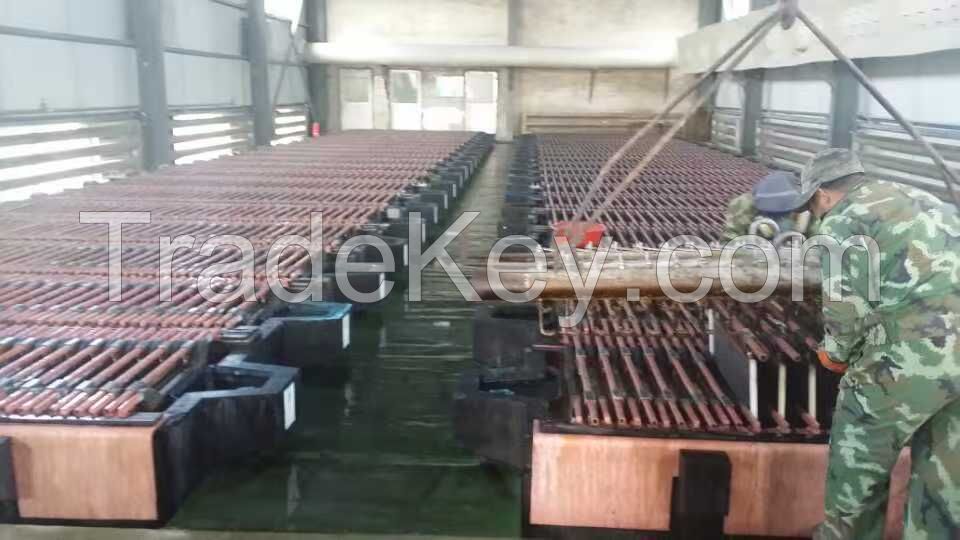
FOB Price
Get Latest Price|
Minimum Order
Place of Origin:
-
Price for Minimum Order:
-
Minimum Order Quantity:
-
Packaging Detail:
-
Delivery Time:
-
Supplying Ability:
-
Payment Type:
T/T
Contact Person mecru
Crushing and grinding are the primary technological processes of copper ore hydrometallurgy. After being crushed, the raw ore enters the ball mill for grinding at a controllable speed, and finally reaches the qualified particle size before entering the next production process. In hydrometallurgy, a certain amount of water needs to be added to the mill to maintain the density of the mill.
Leaching is to select a suitable solvent to selectively dissolve valuable metal elements or harmful impurities in ores, concentrates or smelting intermediate products, and transfer them into the solution to achieve the purpose of separating valuable elements from harmful impurities or gangues . In addition to ores and concentrates, the leaching materials may also be residues after smelting, anode slime, waste alloys, etc.
Raw ores and concentrates are usually composed of a variety of minerals, the composition is very complex, and valuable elements often exist in the form of compounds such as oxides, sulfides, arsenides, carbonates, sulfates, and phosphates. It also exists in the form of metals, such as gold, silver, natural copper and so on. The appropriate solvent and leaching method must be selected according to the characteristics of the raw material.
The purification of the leaching liquor is the process of separating the target metal from the impurities in the solution and removing the harmful impurities in the leaching liquor. During the leaching process of raw ore or concentrate, when the target metal is transferred from the raw material to the solution, certain impurities will also enter the solution.
In order to facilitate precipitation and extraction of the metal of interest, impurities must be removed prior to precipitation to obtain a solution as pure as possible. The purification of leaching liquor is relative. The impurity metals separated by purification are often important raw materials to be recovered as valuable semi-products.
The process of separating and recovering the metal materials contained in the aqueous solution through the conversion of the metal state from the solution is one of the important steps of hydrometallurgy.
The copper hydrometallurgy process uses electrowinning, which refers to the process of depositing or precipitating substances on electrodes. When the current passes through the electrolyte solution, the copper ions on the electrode can be reduced to copper and deposited on the electrode.
The cathode copper produced by the extraction-electrowinning method has a product quality that exceeds that of the cathode copper produced by the smelting-refining method, and reaches or exceeds the national standard for No. 1 cathode copper.



Crushing and grinding are the primary technological processes of copper ore hydrometallurgy. After being crushed, the raw ore enters the ball mill for grinding at a controllable speed, and finally reaches the qualified particle size before entering the next production process. In hydrometallurgy, a certain amount of water needs to be added to the mill to maintain the density of the mill.
Leaching is to select a suitable solvent to selectively dissolve valuable metal elements or harmful impurities in ores, concentrates or smelting intermediate products, and transfer them into the solution to achieve the purpose of separating valuable elements from harmful impurities or gangues . In addition to ores and concentrates, the leaching materials may also be residues after smelting, anode slime, waste alloys, etc.
Raw ores and concentrates are usually composed of a variety of minerals, the composition is very complex, and valuable elements often exist in the form of compounds such as oxides, sulfides, arsenides, carbonates, sulfates, and phosphates. It also exists in the form of metals, such as gold, silver, natural copper and so on. The appropriate solvent and leaching method must be selected according to the characteristics of the raw material.
The purification of the leaching liquor is the process of separating the target metal from the impurities in the solution and removing the harmful impurities in the leaching liquor. During the leaching process of raw ore or concentrate, when the target metal is transferred from the raw material to the solution, certain impurities will also enter the solution.
In order to facilitate precipitation and extraction of the metal of interest, impurities must be removed prior to precipitation to obtain a solution as pure as possible. The purification of leaching liquor is relative. The impurity metals separated by purification are often important raw materials to be recovered as valuable semi-products.
The process of separating and recovering the metal materials contained in the aqueous solution through the conversion of the metal state from the solution is one of the important steps of hydrometallurgy.
The copper hydrometallurgy process uses electrowinning, which refers to the process of depositing or precipitating substances on electrodes. When the current passes through the electrolyte solution, the copper ions on the electrode can be reduced to copper and deposited on the electrode.
The cathode copper produced by the extraction-electrowinning method has a product quality that exceeds that of the cathode copper produced by the smelting-refining method, and reaches or exceeds the national standard for No. 1 cathode copper.



